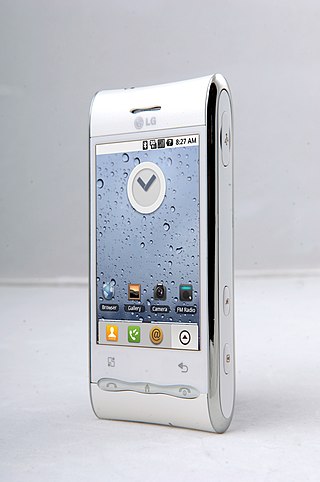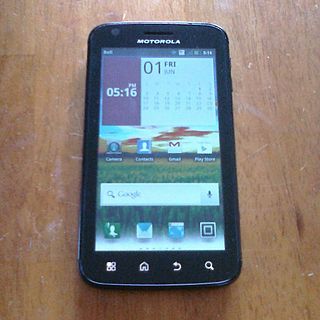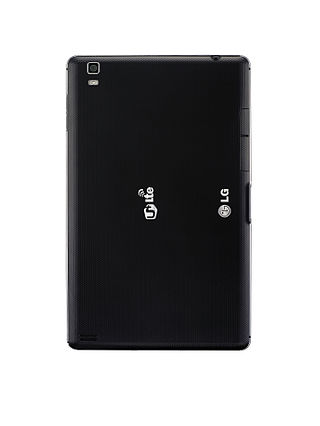Rooting is the process by which users of Android devices can attain privileged control over various subsystems of the device, usually smartphones. Because Android is based on a modified version of the Linux kernel, rooting an Android device gives similar access to administrative (superuser) permissions as on Linux or any other Unix-like operating system such as FreeBSD or macOS.
Google Nexus is a discontinued line of consumer electronic devices that run the Android operating system. Google managed the design, development, marketing, and support of these devices, but some development and all manufacturing were carried out by partnering with original equipment manufacturers (OEMs). Alongside the main smartphone products, the line also included tablet computers and streaming media players; the Nexus started out in January 2010 and reached its end in October 2016, replaced by Google Pixel.

The LG Optimus, also known as the LG Optimus GT540, LG GT540 Swift and the LG Loop GT540, is a mid-level Android smartphone designed and manufactured by LG Electronics. Released running Android 1.6 Donut, the device can be officially upgraded to Android 2.1 Eclair via an LG software release.

The LG Optimus series is a series of smartphones and tablet computers manufactured by LG Electronics. Optimus-branded devices have been produced running both the Android and Windows Phone 7 operating systems.

The Motorola Xoom is an Android-based tablet computer by Motorola, introduced at CES 2011 on January 5, 2011. It was the first tablet to be sold with Android 3.0 Honeycomb. The Verizon branded Xoom was the first tablet to run Android 3.1. The Motorola Xoom went through the FCC on February 10, 2011 only 14 days before release. The 3G version was released on February 24, 2011, and the Wi-Fi version was released March 27, 2011. It was announced concurrently with three other products: the Motorola Atrix, the Motorola Droid Bionic, and the Motorola Cliq 2. CNET named it the "Best of the CES" 2011.

The Motorola Atrix 4G is an Android-based smartphone developed by Motorola, introduced at CES 2011 along with the Motorola Xoom, Motorola Droid Bionic, and Motorola Cliq 2 on January 5, 2011. It was made available in the first quarter of 2011.
The HTC Flyer is a tablet computer by HTC Corporation. It was announced at the Mobile World Congress (MWC) 2011 and released in May 2011. Unlike other tablets announced at MWC, the Flyer has a single-core 1.5 GHz CPU and ran 2.3.3 (Gingerbread). In February 2011 it was reported that HTC had claimed via Facebook that "Flyer will be getting a Honeycomb upgrade in Q2", however an HTC representative subsequently stated "I can confirm that we are working to bring a Honeycomb update to Flyer in short order – however, I don't have any specific information on what the timing may be." The version running Android 3.2 Honeycomb was released later in 2011. The HTC Flyer can be updated up to Android 4.1.2 Jelly Bean through the use of custom ROMs.

The Acer Iconia A500 is a tablet computer designed, developed and marketed by Acer Inc. The A500 launched with the Android Honeycomb operating system which is now upgradable to Ice Cream Sandwich 4.0.3. The tablet is also sold in almost identical form as the Packard Bell Liberty Tab G100.

The Acer Iconia is a range of tablet computers from Acer Inc. of Taiwan.
The Samsung Galaxy R (Royal) (GT-I9103) is an Android smartphone that was announced by Samsung on August 10, 2011 as a variant to the Samsung Galaxy S II.

The Asus Eee Pad Transformer TF201 or Asus Eee Pad Transformer Prime is a 2-in-1 detachable tablet from the Asus Transformer Pad series. It is the world's first Android tablet computer with a quad-core processor, and a successor to the dual-core Asus Eee Pad Transformer. It runs Android 4.1. The Transformer Prime was announced by Asus on 9 November 2011. It was released in Taiwan on 1 December 2011, and in Canada and the United States during the week of 19 December 2011.

The LG Optimus 4X HD is a slate, multi-touch smartphone running the Android operating system. Designed and manufactured by LG Electronics. The Optimus 4X HD was the world's first smartphone announced with a quad-core processor along with the HTC One X and the Samsung Galaxy S3 and the fourth phone in the LG Optimus-Android series. LG first introduced the LG Optimus 4X HD at Mobile World Congress. The Optimus 4X HD was launched with Android 4.0 Ice Cream Sandwich. Since April 2013, some variants have had a Jellybean update available.

The LG Optimus G is a smartphone designed and manufactured by LG Electronics. It was announced on September 19, 2012; On January 18, 2013, LG announced that the device reached 1 million in sales four months after its release in Korea, Japan, Canada, and the U.S. The LG Optimus G is also closely related to the Nexus 4 with similar specifications and a similar design.

The LG Optimus Vu is an Android smartphone/tablet computer hybrid ("phablet"), released in August 2012 and noted for its 4:3 aspect ratio 5.0-inch screen size—between that of conventional smartphones, and larger tablets. It is powered by a 1.5 GHz quad-core Nvidia Tegra 3 CPU with Nvidia ULP GeForce GPU. The Korean version of the phone, known as LG Optimus Vu F100S was released in March, 2012, with a dual-core 1.5 GHz Qualcomm MSM 8660 Snapdragon CPU and Adreno 220 GPU, and with Android 2.3.5 Gingerbread. The Korean model has since received updates to Android 4.0.4 Ice Cream Sandwich and Android 4.1.2 Jelly Bean.

The Nexus 4 is an Android smartphone co-developed by Google and LG Electronics. It is the fourth smartphone in the Google Nexus product family, unveiled on October 29, 2012, and released on November 13, 2012, and succeeded the Samsung-manufactured Galaxy Nexus. As with other Nexus devices, the Nexus 4 was sold unlocked through Google Play, but was also retailed by wireless carriers.

The LG G Pad 8.3 is an 8.3-inch (21 cm) Android-based tablet computer produced and marketed by LG Electronics. It belongs to the LG G series, and was announced on 4 September 2013 and launched in November 2013. Unlike its predecessor which had an 8.9-inch (23 cm) screen, the G Pad 8.3 has a smaller 8.3-inch (21 cm) screen.

The LG Vu 3 is an Android smartphone/tablet computer hybrid ("phablet"), released in September 2013 and noted for its 5.2-inch screen size—between that of conventional smartphones, and larger tablets. It is powered by a 2.26 GHz quad-core Krait 400 CPU with Adreno 330 GPU and runs on Android 4.2.2 Jelly Bean. Android 4.4.2 KitKat was also announced for update on 14 March, 2014.

The LG Optimus Pad LTE is a tablet computer developed by LG Electronics as a direct successor to the original LG Optimus Pad released in South Korea in January 2012. The LG Optimus Pad LTE was planned to be released worldwide but was cancelled due to its lackluster sales in its domestic market and mixed-to-negative reception towards the device leaving LG to withdraw in the tablet making for a brief period in the world market before the release of its successor the LG G Pad 8.3.

OmniROM is an open-source operating system for smartphones and tablet computers, based on the Android mobile platform. It involves a number of prominent developers from other projects.

Bootloader unlocking is the process of disabling the bootloader security that makes secure boot possible. It can make advanced customizations possible, such as installing a custom firmware. On smartphones this can be a custom Android distribution or another mobile operating system. Some bootloaders are not locked at all, others can be unlocked using a standard command, others need assistance from the manufacturer. Some do not include an unlocking method and can only be unlocked through a software exploit.















